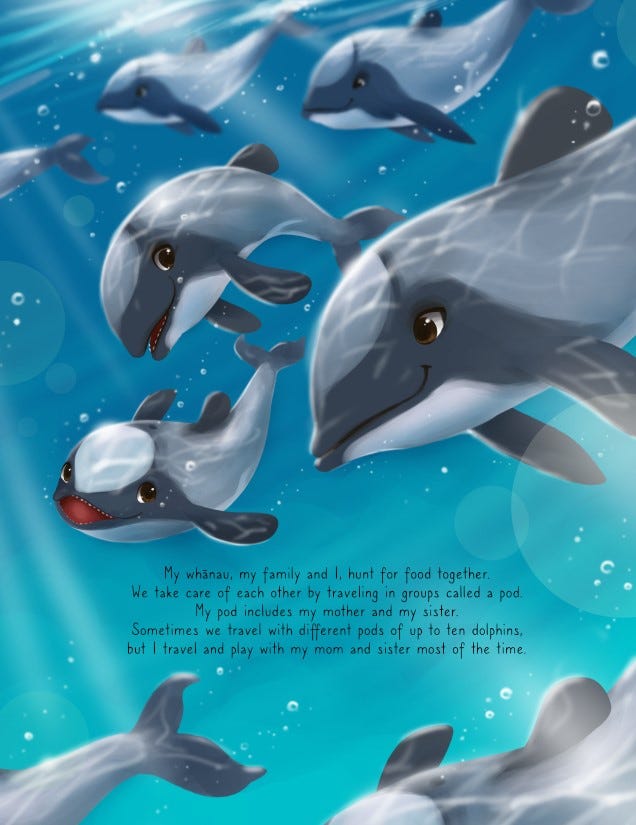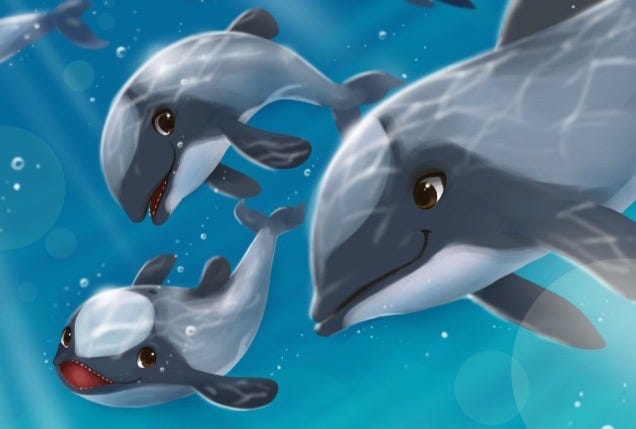Noemi Knight is passionate about the playful Maui dolphins and an advocate to save this subspecies of the Hector dolphin.

The author, NOEMI KNIGHT Won’t give up without a Fight
Noemi refuses to give up on her favorite animals, and the book is full of suggestions for action to save one of the world’s smallest and rarest marine dolphins (the rarest would be the ‘Vaquita’ found in the Gulf of Mexico). Giving up has never been an option for Noemi; she overcame many challenges and finished high school only at 22. But since then, Noemi completed a Bachelor’s in the Japanese language and now has a Master’s degree. She learned a lot about learning during her journey, making her a passionate teacher.
Listen to her interview here: Noemi’s book about the Maui dolphins, their challenges, the protection measures, Noemi’s journey to become an author, and her new plans, click here.
Her project could use your support; click here for her Kickstarter page.
From Alex Verbeek’s original live podcast on @callin.
Popoto, The Maui Dolphin
I must admit that I have never heard of the Maui dolphin; why did you take these dolphins as the theme for your book?
I will admit that when I first looked them up, I had never heard of them either. The story of how I rediscovered these small dolphins starts back in the 1980s. My grandparents had taken me to Auckland, New Zealand, for vacation, and they had taken a series of photos of us out on the water with some dolphins. Last year, so many decades later, I went back home to the States to help with my parents’ household. My kids and I dug through some boxes, and we rediscovered these old photos. I remembered seeing them, but I couldn’t recognize the species. My son kept asking me what kind of dolphins are these? They were unusual looking. They’re tiny and have a rounded dorsal fin; it’s called the Mickey Mouse ear dorsal fin. And so, I looked it up because I wasn’t sure what they were either. And that’s when I discovered that they were the Maui dolphins.
And in those days when you first saw them, there must have been many more dolphins than there are today?
Oh yes, back in the 1980s and 90s, there were a lot more Hector and Maui dolphins. The Hector’s dolphins live near the South Island of New Zealand, and the Maui dolphins live west of the North Island of New Zealand. They are pretty similar but genetically different, so they can’t interbreed. Sadly, both subspecies are endangered; there are an estimated five to six-thousand remaining Hector’s dolphins, while the Maui dolphins are down to less than 60.

That is terrible. The last time we spoke, their numbers were slightly above 60, and now we’re below 60, why are the population numbers going down?
Sadly, there have been a few deaths. When we last spoke, I think there were still 64, so it is now around 60. The leading cause of the dolphins’ deaths is fishing nets. Unfortunately, humans prefer the same seafood as the Maui dolphin, like codfish, squid, or crabs. So, fishermen put the nets in the areas where these dolphins live; they get caught in them and drown.
Unlike other dolphin species, these are only around 50 kilos and about 1.5 meters long. So, it’s about the size of an average 11 to 15-year-old kid. And because they’re such small coastal dolphins, they breathe more often than species like the bottlenose dolphins that people are more familiar with. The Maui dolphins come up to breathe every four to five minutes. So, if they get entangled in a net, it’s far more dangerous for them, and it’s critical that people can get to them and free them from these nets.
So what is the New Zealand government doing to protect them?
One of the big pushes is the “100-meter project” that aims to keep fishermen further from the coast and check their nets more often. One of the biggest problems is that the fishing industry conflicts with tourism, which conflicts with conservationist organizations. We need mediation between these groups to protect the dolphins, but they all have different interests.

Is fishing the only problem, or are other developments like climate change and pollution playing a role?
Climate change definitely plays a role. For example, there have been many more storms around the Polynesian islands, making it harder for surface swimming dolphins to come up to breathe; some Maui dolphins have been found on beaches.
Pollution is also a factor; first of all, plastic pollution breaks down to microplastics and ends up in the dolphin’s food chain. But researchers have found that toxoplasmosis is also affecting these mammals. The many cats on the islands cause it. When they urinate on the ground, it ends up in the ocean; there is evidence of a few miscarriages from Maui dolphins directly from toxoplasmosis.
I can imagine it must have been a challenge to write about the dolphins’ sad situation in a children’s book.
Yes, it was a challenge. I wanted to stay positive; it’s a kid’s book. But, I also wanted to keep the positivity that we can do things; I wanted the kids to be aware of the bad stuff and be realistic about them. And then, I also aimed to be friendly and inviting. So, I have a few pages that talk about the most significant threats: overfishing and pollution. And one of the images shows a Maui dolphin caught in the net. But he does get out of it.
I wanted to focus on the positive, that “green optimism” that Erik Solheim talked about in your recent interview. First of all: the numbers can still be recovered. We are up from 40 to roughly 60 Maui dolphins, so they are recovering. And then second, we can stop further damage from happening. It isn’t hopeless. We can prevent this from happening. We can reverse these developments, and kids can help by taking positive action.
How does someone start writing a children’s book? Before you decided to write a children’s book, what was your journey?
As I was growing up, I knew for sure that I wanted to work with animals; I wanted to be a veterinarian or anything that ended in “ologist”. I was obsessed with dinosaurs. But when I was in fourth grade, I started to realize that I had some problems with mathematics. And by the time I was in fifth grade, I had been diagnosed with dysgraphia and dyscalculia, a learning disability that affects specifically math. So I have problems telling time or doing any type of math problems. That’s why I graduated from high school with a special education diploma. But unfortunately, special education diplomas aren’t accepted in most colleges or military service or any of that. So I ended up working on one of my first jobs in a fast-food restaurant.
My Unique Life Experiences led me to Teaching + Further Education
My lucky day was when my old high school math teacher found me there one day. And you know, she still knew that I was passionate about doing other things. So she arranged for me to go back to school and give me a tutor. She also arranged to use a calculator, and I got extended time for the state exams.
And so, a few years later, I finally graduated High School at the age of 22. I then served four years in the US Army, and by the time I got out, I started to study Japanese and got my bachelor’s degree. I know it sounds strange: I can learn Japanese, but I couldn’t do math. So I then got my master’s degree in teaching English as a second language, and then I decided to get my kindergarten-to-12th-grade teaching licensure.
And now, years later, I’m homeschooling my son. He also has learning disabilities, in his case with dyslexia, but he knows so much about marine life, especially sharks. That, combined with my passion for drawing and teaching, made me think about making a children’s book about the Maui dolphins that I had seen decades ago in New Zealand. So I then got in touch with a fantastic artist, Alvin Adhi (on Instagram: @alvin_adhi), who specializes in underwater art. We soon decided to work together on this project.
Do you already have the next projects in mind? Your book has a powerful Message
I want to write as many books as I can. So I organized a vote between the Hawksbill Sea Turtle and the Axolotl for the next book. My son, my husband, and many other people voted for the Axolotl because most of them have heard about this remarkable salamander species. Still, they didn’t know that these unique animals are also critically endangered in the wild. Less than a thousand of them live in only one lake in Mexico.

I saw the finalized version of your book in a pdf format, but I understand that the printing can only begin once you have a minimum amount of funds?
Yes, I have a Kickstarter campaign. I ask for $4,000 because that covers all the printing and shipping costs for the books. That is the most expensive part; we have already paid for the illustrations and extras like bookmarks. Anything else that I need extra will come out of pocket. Kickstarter is not a charity; if the book doesn’t get funded, I don’t get any of the funds, and the supporters will keep their money.
I have the cute little collectible pins that will only be available to backers on Kickstarter. So once those are gone, those are gone. And I made worksheets for a teacher’s curriculum guide to use the book in their classrooms. As a teacher, I know it is always challenging to develop a curriculum yourself because there wasn’t one available.
I received a lot of help from the New Zealand Whale and Dolphin Trust and the country’s best expert on Maui dolphins. So, therefore, one dollar of every pledge goes directly to this organization and the invaluable research they are doing.
Please support the publication of this wonderful book:
Support the publication of Popoto here.

To listen to the entire 42-minute interview about Noemi’s book about the Maui dolphins, their challenges, the protection measures, Noemi’s journey to become an author, and her new plans, click here.
I write these newsletters, share my photos, do interviews, make podcasts about the environment, and share my travels because I believe that together we can do better on this beautiful but fragile planet.
If you are a paying subscriber: thank you for your support!
Please consider supporting this initiative by taking a paid subscription if you are not.Subscribe
If the cost of this newsletter ($6/month, $60/year) would create any financial strain, please stay on the free list; I value all readers.







